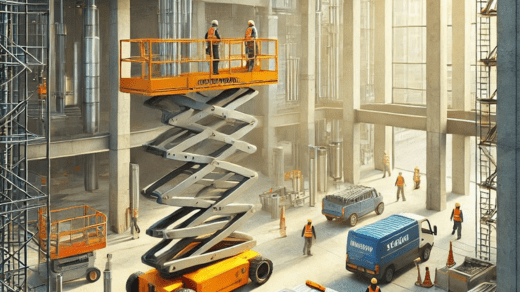Benefits of Using Scissor Lifts in Construction Projects
Scissor lifts offer construction projects numerous advantages, such as increased safety for workers at elevated heights. With stable platforms and guardrails, scissor lifts provide a secure working environment that minimizes the risk of accidents. scissor lift hire This not only protects the workers but also reduces the likelihood of project delays due to injuries.Furthermore, scissor lifts contribute to enhanced productivity on construction sites by offering versatility in reaching various heights with ease. This efficiency allows workers to complete tasks effectively and quickly, saving both time and labor costs. Additionally, scissor lifts can access tight or confined spaces, increasing accessibility on the site and streamlining workflows.
Types of Scissor Lifts Available for Construction Projects
Scissor lifts are available in various types to cater to different construction project needs. Electric scissor lifts are popular for indoor projects due to their quiet operation and zero emissions, making them ideal for environmentally sensitive areas. Rough terrain scissor lifts, on the other hand, are designed for outdoor use on uneven surfaces, offering stability and maneuverability on rugged construction sites. Furthermore, compact scissor lifts are a great choice for projects with limited space as they can easily navigate through tight areas. On the other end of the spectrum, high-reach scissor lifts are suitable for tasks that require reaching greater heights, offering extended platform heights for working on tall structures such as ceilings or high-rise buildings. Each type of scissor lift serves a specific purpose, and choosing the right one can significantly impact the efficiency and safety of construction projects.
Safety Features to Consider When Using Scissor Lifts
When operating scissor lifts on construction sites, it is crucial to prioritize safety at all times. One of the key safety features to consider when using scissor lifts is the presence of guardrails surrounding the platform. Guardrails help prevent falls and provide a barrier for workers to lean against, reducing the risk of accidents. Additionally, ensuring that the scissor lift is equipped with an emergency lowering system can be life-saving in the event of a power failure or malfunction.Another important safety feature to look for in scissor lifts is the presence of sensors or alarms that alert operators when the lift is nearing its maximum height or weight capacity. uphire These warnings help prevent overloading and instability, reducing the risk of tip-overs or structural failures. Additionally, having a secure platform with non-slip flooring can enhance worker stability and prevent slips and falls while working at height.
Factors to Consider When Choosing a Scissor Lift for Your Project
When selecting a scissor lift for your construction project, one crucial factor to consider is the height requirement. Ensure that the maximum platform height of the scissor lift aligns with the needs of your project, allowing workers to safely reach the desired working height without limitations. Additionally, take into account the weight capacity of the scissor lift to support the tools, materials, and workers that will be on the platform, preventing any overload situations that could compromise safety.Another key consideration when choosing a scissor lift is the type of terrain it will be operating on. Different models are designed for specific terrains, such as indoor smooth surfaces or rough outdoor environments. By matching the scissor lift to the terrain conditions of your project site, you can optimize performance and ensure stability during operation.
How Scissor Lifts Improve Efficiency on Construction Sites
Scissor lifts play a vital role in enhancing efficiency on construction sites. With their ability to elevate workers and materials to various heights, scissor lifts enable tasks to be completed quickly and accurately. This efficient vertical transport ensures that workers have easy access to different areas of the construction site, reducing the time and effort required to move equipment and complete tasks.Moreover, scissor lifts provide a stable platform for workers to perform their tasks safely and effectively. By eliminating the need for ladders or scaffolding, scissor lifts enable workers to work at height with greater stability and security. This increased safety factor not only enhances efficiency by reducing the risk of accidents but also allows workers to focus on their tasks without worrying about their safety.
Common Applications of Scissor Lifts in Construction Projects
Scissor lifts are versatile pieces of equipment widely used in construction projects. One common application of scissor lifts is their use for installing electrical fixtures and systems at heights. Electricians can easily maneuver scissor lifts to reach elevated areas safely, making it efficient to install lighting, wiring, and other essential electrical components in buildings under construction.Another common application of scissor lifts in construction projects is for painting tasks. Painting high ceilings, walls, and even exterior surfaces of buildings can be challenging without the help of a scissor lift. With the platform’s stability and ability to reach tall heights, painters can work comfortably and with precision, ensuring a smooth and even coat of paint throughout the project.
Maintenance Tips for Keeping Scissor Lifts in Good Working Condition
Regular maintenance is essential for keeping scissor lifts in good working condition. One key tip is to schedule routine inspections to check for any signs of wear and tear, such as hydraulic leaks or worn-out components. Addressing these issues promptly can prevent more significant problems down the line and ensure the safety of workers using the lift.Another essential maintenance tip is to follow the manufacturer’s recommended maintenance schedule for your specific scissor lift model. This may include tasks such as lubricating moving parts, inspecting electrical components, and checking the overall structural integrity of the lift. By staying on top of these routine maintenance tasks, you can prolong the lifespan of the scissor lift and avoid costly repairs or replacements.
Training Requirements for Operating Scissor Lifts Safely
Training for operating scissor lifts is crucial to ensure the safety of workers on construction sites. Individuals operating scissor lifts must be properly trained on how to safely maneuver the equipment, understand weight limits, and follow all safety protocols. This training typically includes instruction on how to conduct pre-operational checks, how to properly secure the lift, and what to do in case of an emergency or equipment malfunction.In addition to operational training, individuals operating scissor lifts are usually required to undergo training in fall protection and rescue procedures. This additional training ensures that operators are equipped to handle potential accidents or emergencies while working at heights. By providing comprehensive training for scissor lift operators, construction companies can create a safer work environment and reduce the risks associated with working with this equipment.
Cost Considerations for Renting or Purchasing a Scissor Lift
When considering the cost of renting or purchasing a scissor lift for your construction project, it is important to weigh the upfront expenses against the long-term benefits. Renting a scissor lift may be a cost-effective option for short-term projects or occasional use, as it avoids the initial purchase price and ongoing maintenance costs. However, for frequent use or extended projects, purchasing a scissor lift may prove to be more economical in the long run, especially if resale value is taken into account.Additionally, when determining the cost considerations for renting or purchasing a scissor lift, factors such as delivery fees, transportation costs, and insurance coverage should be factored in to get a comprehensive understanding of the overall expenses involved. It is crucial to thoroughly assess your project requirements, budget constraints, and duration of use to make an informed decision on whether renting or purchasing a scissor lift is the most cost-effective option for your specific construction needs.
Case Studies of Successful Construction Projects Utilizing Scissor Lifts
In a high-rise commercial building project in downtown, a scissor lift played a pivotal role in facilitating efficient work at height. By providing workers with a stable platform to access various levels of the structure, the scissor lift significantly increased productivity while ensuring safety protocols were adhered to. This project exemplified how the use of a scissor lift can streamline construction processes, particularly when working on complex architectural designs that require precise positioning of workers and equipment.Another notable case study involves the renovation of a historic landmark in a bustling city center. The project team utilized scissor lifts to access intricate details of the building’s facade, enabling them to carry out restoration work with precision and care. The maneuverability and ease of operation of the scissor lifts proved instrumental in completing the project on time and within budget, showcasing the versatility and effectiveness of this equipment in heritage conservation projects.


